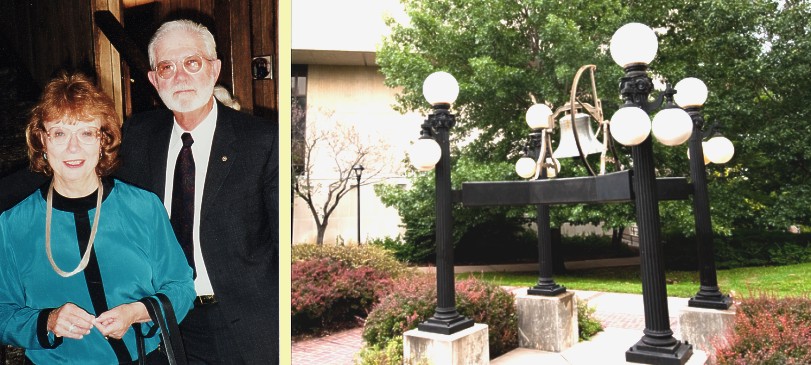
Kansas Snapshots by Gloria Freeland - May 18, 2012
"Bring it forward"
I am always on the lookout for hands-on projects for my students. I think they are more interesting than having them do textbook exercises. Since Kansas State University is celebrating its sesquicentennial next year, I thought it would provide a good opportunity for them to learn more about the people, buildings and traditions of the university and to relate them to the present. So for the final assignment, I asked them to "bring it forward" - to show the significance of the history they discovered to what is on campus today.
At first, they balked. It wasn't a cut-and-dried assignment. It would require them to put together research on both the past and present and combine it with interviews to craft well-written stories. But once they started, they got excited.
And last week as I read their final papers, I got excited, too. They discovered a lot of interesting facts.
- K-State's mascot wasn't always Willie the Wildcat. From 1906 through 1909, it was a black Labrador named Boscoe.
- Life was difficult for those who lived during the Dust Bowl days.
"Oh, the dust storms, you'd see them coming," one woman said. "It was just a solid mass of dark cloud. They sent us home from
school when I was in the third grade. All the street lights were on and it was kind of scary."
- Life at the university wasn't insulated from the effects of the Depression. Forty-three faculty members were let go between June 1931 and June 1934, and salaries were cut by 10 percent during 1932 and 1933.
- The G.I. Bill - a government program to reward soldiers for their service in World War II - had an impact on K-State
alumni who used it.
"My experience here at K-State was wonderful," one veteran said. "All around everyone was dedicated to improve their situation
with this wonderful opportunity. The Army taught me everything I needed to be ready: discipline, time management and teamwork.
And on top of that, they gave you $40-50 a week for living expenses. The G.I. Bill was one of the most effective government
programs we have ever had."
- World War II also affected life on campus. The Red Cross offered classes on first aid, nursing, knitting and garment making. The university organized scrap metal drives and war bond drives.
- The Bluemont Bell has had quite a journey since its casting in West Troy, New York in 1861. It was given to Bluemont Central College - K-State's predecessor - by Joseph Ingalls, a Swampscott, Mass. philanthropist. When the original limestone building where it hung was torn down in the 1880s, the bell was moved to the tower of Anderson Hall, K-State's administration building. It called students to classes until 1966 when that task was turned over to a carillon.
The bell sat in the tower unused for many years. In 1994, after lightning struck the tower and caused a fire, it was rediscovered by facilities workers. It was then moved to a spot on the west side of Bluemont Hall, which houses K-State's College of Education.
That last story piqued my curiosity. I knew former colleague and friend Nancy Hause and her husband Rich also played a part in the last leg of the bell's journey. Wanting to know "the rest of the story," I contacted her.
She said that after she heard about the bell's re-discovery, an idea struck her. Rich, a professor of education who had loved teaching, was about to retire. She thought arranging to have the historic bell placed on display outside Bluemont Hall would be a nice tribute to his work at the university.
Without his knowledge, she assembled a group to finance the project.
There was some concern the tower had been constructed around the bell and so could not be removed. One day a crane that was being used to work on the library became available and was moved to Anderson Hall. To everyone's relief, the bell was removed without incident.
Then it was cleaned and polished by a local metal specialist.
When Rich decided to throw himself a retirement party in Wamego, a town about 15 miles east of Manhattan, arrangements were made to have a truck haul the bell there. It was then he first learned of Nancy's plan.
After its return from Wamego, the bell was moved to its final destination outside of Bluemont Hall where it was hung from beams supported by four lampposts that had been given by the class of 1912, but had been in storage for years.
But there was still more. After a local newspaper ran an article about the bell, a woman sent the original clapper to the dean of the college. It had been stolen as a student prank in the early 1900s and had remained in the family.
After Rich died in 2005, Dean Mike Holen led a service by the bell for Rich at the same time as his memorial service was being held in Estes Park, Colo. where he and Nancy had retired.
And then he rang the bell.
Reflecting on the work my students did on the various articles, I thought most of them effectively connected the past with the present. What better proof was needed than the fact they even inspired their teacher to do a little more research of her own!

Left: Nancy and Rich Hause when our family visited them in Colorado in 1997; right:the Bluemont Bell outside of Bluemont Hall.
Comments? [email protected].
Earlier columns from 2012 may be found at: 2012 Index.
Links to previous years are on the home page: Home